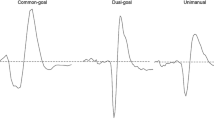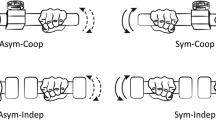Abstract
In six healthy right-handed volunteers, we compared the cerebral activation pattern related to unimanual right- and left-hand movements and to bimanual in-phase and anti-phase movements using functional magnetic resonance imaging (fMRI). Internally paced unimanual finger-to-thumb opposition movements led to a strong contralateral activation of primary sensorimotor areas in all six subjects. Midline activity was lateralized to the left side during right-hand movements, but to both sides during left-hand movements. Activity patterns of bimanual in-phase movements resembled the combined activity patterns of the two unimanual conditions: right and left hemispheric activations of the primary sensorimotor cortices and predominantly left-sided medial frontal activity. In contrast, during anti-phase movements, we observed a clear increase in activity, in both right and left frontal midline areas and in right hemispheric, mainly dorsolateral premotor areas compared to in-phase movements. These results indicate that frontal midline activity is not specific for bimanual movements per se. It can already be involved during simple unimanual movements but becomes progressively more involved during more complex aspects of movement control.
Similar content being viewed by others
Author information
Authors and Affiliations
Additional information
Received: 20 September 1998 / Accepted: 24 February 1999
Rights and permissions
About this article
Cite this article
Stephan, K., Binkofski, F., Posse, S. et al. Cerebral midline structures in bimanual coordination. Exp Brain Res 128, 243–249 (1999). https://doi.org/10.1007/s002210050844
Issue Date:
DOI: https://doi.org/10.1007/s002210050844




